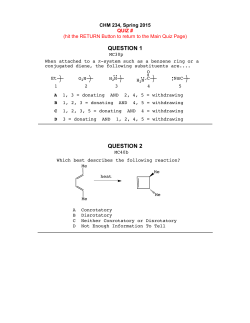
HERE
CHM 234, Spring 2015 QUIZ #10 ANSWER KEY (hit the RETURN Button to return to the Main Quiz Page) QUESTION 1 MC32n For the following reactions indicated as 1, 2 and 3, which is the correct order of INCREASING rate of electrophilic aromatic substitution? O N O NO2 1 NH2 2 Cl 3 Cl2 AlCl3 this is STRONG WITHDRAWING group due to the formal positive charge on the nitrogen in the nitro group, so is DEACTIVATING, and decreases the reaction rate this is a STRONG DONATING group on a πsystem, due to the resonance effect of Cl2 the non-bonding electrons on the nitrogenm, thus is ACTIVATING, and AlCl3 increases the rate of the reaction this is WEAK WITHDRAWING group, even though the Cl has non-bonding electrons Cl2 it is so electronegative that the inductive effect outweighs the weak AlCl3 resonance donation effect, Cl is thus DEACTIVATING and decreases the reaction rate somewhat A 1 (slowest) < 2 < 3 (fastest) B 2 (slowest) < 3 < 1 (fastest) C 1 (slowest) < 3 < 2 (fastest) D 3 (slowest) < 2 < 1 (fastest) QUESTION 2 MC32o give the product of the following electrophilic aromatic substitution reaction CN HNO3/H2SO4 NO2 CN CN O2N CN O2N A B C Do not give the answer D meta-position + C N = CN HNO3/H2SO4 electron withdrawing due to dipolar nature of the carbon-nitrogen triple bond, thus META-directing O2N CN QUESTION 3 MC32l Which of the following structures would undergo electrophilic aromatic substitution fastest? Me O O N H Me B A O N H OMe O N H N H MeO C D donating groups are ACTIVATING, they make electrophilic aromatic substitution reactions FASTER, the stronger the donating group, the faster the reaction O weak donating N moderate H withdrawing #1 Me O B N moderate H withdrawing #1 O strong donating #1 MeO O N moderate H withdrawing O D #2 N moderate H donating MeO OMe moderate donating O C Me weak donating #2 N H N moderate H withdrawing #2 N moderate H donating Me Me O #1 O A #2 OMe strong donating N moderate H donating the #2 ring in structure D has both moderate and a strong donating groups, THIS ring on THIS structure is the most activated, reaction would be fastest HERE QUESTION 4 QUESTION 5 QUESTION 6 QUESTION 7 QUESTION 8
© Copyright 2025










